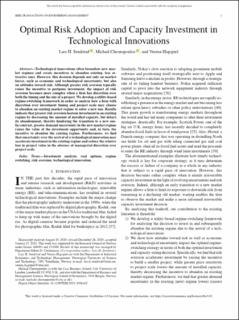| dc.contributor.author | Sendstad, Lars Hegnes | |
| dc.contributor.author | Chronopoulos, Michail | |
| dc.contributor.author | Hagspiel, Verena | |
| dc.date.accessioned | 2021-09-17T06:21:14Z | |
| dc.date.available | 2021-09-17T06:21:14Z | |
| dc.date.created | 2021-03-03T08:30:05Z | |
| dc.date.issued | 2021 | |
| dc.identifier.citation | IEEE transactions on engineering management. 2021, 1-14. | en_US |
| dc.identifier.issn | 0018-9391 | |
| dc.identifier.uri | https://hdl.handle.net/11250/2778766 | |
| dc.description.abstract | Technological innovations often formulate new market regimes and create incentives to abandon existing, less attractive ones. However, this decision depends not only on market forces, such as economic and technological uncertainty, but also on attitudes toward risk. Although greater risk aversion typically raises the incentive to postpone investment, the impact of risk aversion becomes more complex when a firm has discretion over both the timing and the size of a project. We develop a utility-based regime-switching framework in order to analyze how a firm with discretion over investment timing and project scale may choose to abandon an existing market regime to enter a new one. Results indicate that greater risk aversion hastens investment in an existing regime by decreasing the amount of installed capacity, but delays its abandonment, thereby hindering the transition to a new one. In contrast, greater demand uncertainty in the new market regime raises the value of the investment opportunity and, in turn, the incentive to abandon the existing regime. Furthermore, we find that uncertainty over the arrival of a technological innovation may accelerate investment in the existing regime and reduce the relative loss in project value in the absence of managerial discretion over project scale. | en_US |
| dc.language.iso | eng | en_US |
| dc.publisher | IEEE | en_US |
| dc.rights | Navngivelse 4.0 Internasjonal | * |
| dc.rights.uri | http://creativecommons.org/licenses/by/4.0/deed.no | * |
| dc.title | Optimal Risk Adoption and Capacity Investment in Technological Innovations | en_US |
| dc.type | Journal article | en_US |
| dc.type | Peer reviewed | en_US |
| dc.description.version | publishedVersion | en_US |
| dc.source.pagenumber | 1-14 | en_US |
| dc.source.journal | IEEE transactions on engineering management | en_US |
| dc.identifier.doi | 10.1109/TEM.2021.3056142 | |
| dc.identifier.cristin | 1895120 | |
| dc.relation.project | Norges forskningsråd: 274569 | en_US |
| dc.relation.project | Norges forskningsråd: 268093 | en_US |
| cristin.ispublished | true | |
| cristin.fulltext | original | |
| cristin.qualitycode | 1 | |

